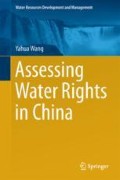Abstract
This chapter studies the developments of water market in contemporary China by the case study method under the water rights hierarchy framework. Six cases have been selected, all taking place over the past 15 years, which reflect the latest changes in the water rights structure. This chapter aims to reveal theoretical implications of these cases. First of all, the author presents an analytical framework for the case study and divides the six cases into five categories according to the water rights hierarchy conceptual model. The first category covers water rights trading at the user level as depicted by the case in the Hongshui Irrigation Area of Minle County in Northwest China’s Zhangye Prefecture, with the irrigation water rights trading in the Guangzhong Area during the Qing Dynasty as a contrast for comparative study. The second category deals with water rights trading at the group level as shown in the case an industrial firm buying agricultural water rights in the Yellow River basin. The third category is about water rights trading at the local government level, with the Dongyang-Yiwu long-term water rights transfer and a short-term water rights transfer, in the upper reaches of the Zhanghe River. The fourth category covers what is known as water bank that is regulated and controlled by superordinates, which is still in the process of planning in the Yellow River basin. The fifth category is the initial water rights allocation by the market within the plan of South-to-North water diversion project. The first four cases are the emphasis of the study in this chapter, as they are all rights trading among decision-making entities at the same level. The chapter winds up with a summary of the cases.
Access this chapter
Tax calculation will be finalised at checkout
Purchases are for personal use only
Notes
- 1.
This difference leads to the different characteristics of urban water and irrigation water. In cities, many users can obtain water from the same water supply pipelines while irrigation water users have to get water according to the sequential order. This is very important, because it determines that urban water supply makes it easy for introducing market mechanism but planned way is stressed in the use of irrigation water and it needs large scaled collective cooperation. Historically, such special features of the irrigation system had a great bearing on the development of the oriental civilization.
- 2.
information collected at Water Rights Seminar organized by the Ministry of Water Resources , on August 27–28, 2001, in Beijing.
- 3.
In the planned economy before reform and opening up, the shortage of water governance input by the state was mainly made up for by labor days put in by the peasants. In the whole age of the planned economy, investments in water resources main came from state and the rural people, with the state investment accounting for 2/3 and that by rural people, 1/3. The labor put in by peasants may be regarded as the source and basis for irrigation water rights held by the rural areas.
- 4.
In fact, in ancient society, some small irrigation channels were built by peasants by pooling funds and water rights were therefore owned by collectives. There are some other small irrigation projects were run by merchants and water rights were held by private persons. All these are instances for tying investment to initial allocation of water rights.
References
Gao, E. (2006). Water rights system development in China. Beijing: China Water and Hydropower Publishing (in Chinese).
Hart, B. T. (2016a). The Australian Murray–Darling basin plan: Challenges in its implementation (Part 1). International Journal of Water Resources Development, 32(6), 819–834. doi:10.1080/07900627.2015.1083847.
Hart, B. T. (2016b). The Australian Murray–Darling basin plan: Challenges in its implementation (Part 2). International Journal of Water Resources Development, 32(6), 835–852. doi:10.1080/07900627.2015.1084494.
Israel, M., & Lund, J. R. (1995). Recent California water transfers: Implications for water management. Natural Resources Journal, 35(1), 1–32.
Mitchell, B., Priddle, C., Shrubsole, D., Veale, B., & Walters, D. (2014). Integrated water resource management: Lessons from conservation authorities in Ontario, Canada. International Journal of Water Resources Development, 30(3), 460–474. doi:10.1080/07900627.2013.876328.
Speed, R. (2009a). A comparison of water rights systems in China and Australia. International Journal of Water Resources Development, 25(2), 389–405. doi:10.1080/07900620902868901.
Speed, R. (2009b). Transferring and trading water rights in the People’s Republic of China. International Journal of Water Resources Development, 25(2), 269–281. doi:10.1080/07900620902868687.
Wang, S. (2000). Water rights and water market: Economic means for optimizing the allocation of water resources. Paper presented at the Annual Meeting of the China Water Resources Society, Beijing
Wang, Y. (2001). China’s institutional reform of water resources allocation as seen from water rights trading between Dongyang and Yiwu Cities. China Water Resource, 6, 35–37 (in Chinese).
Wang, S. (2003a). Use the sustainable utilization of water resources to stimulate the sustainable economic and social development. Paper presented at the Ministerial Meeting of the Third World Water Forum, Tokyo, Japan.
Wang, Y. (2003b). How should China build a water-efficient society: Investigation report on the experiments in building a water-efficient society in Zhangye, Gansu Province. Paper presented at the CAS-Tsinghua Center for China Studies, Beijing.
Wang, Y. (2013a). Research on the stages of water conservancy development in China. Beijing: Tsinghua University Press (in Chinese).
Wang, Y. (2013b). Water governance reform in China. Beijing: Tsinghua University Press (in Chinese).
Xia, C., & Pahl-Wostl, C. (2012). The development of water allocation management in the Yellow River basin. Water Resources Management, 26(12), 3395–3414. doi:10.1007/s11269-012-0078-1.
Author information
Authors and Affiliations
Rights and permissions
Copyright information
© 2018 Springer Nature Singapore Pte Ltd.
About this chapter
Cite this chapter
Wang, Y. (2018). Water Rights and Water Market: Case Study in Contemporary China. In: Assessing Water Rights in China. Water Resources Development and Management. Springer, Singapore. https://doi.org/10.1007/978-981-10-5083-1_7
Download citation
DOI: https://doi.org/10.1007/978-981-10-5083-1_7
Published:
Publisher Name: Springer, Singapore
Print ISBN: 978-981-10-5082-4
Online ISBN: 978-981-10-5083-1
eBook Packages: Earth and Environmental ScienceEarth and Environmental Science (R0)

